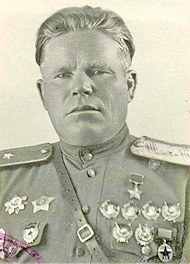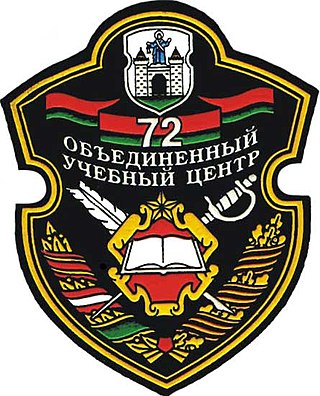
The 4th Guards Army was an elite Guards field army of the Soviet Union during World War II and the early postwar era.
The 75th Guards Rifle Division was a Red Army infantry division during World War II and afterwards, which later became the 75th Guards Tank Division and was finally disbanded in the 1990s.

The 5th Guards Army was a Soviet Guards formation which fought in many critical actions during World War II under the command of General Aleksey Semenovich Zhadov. The 5th Guards Army was formed in spring 1943 from the 66th Army in recognition of that army's actions during the Battle of Stalingrad. The 5th Guards Army fought in the Battle of Kursk, Belgorod-Khar'kov Offensive Operation, Battle of the Dnieper, Uman–Botoșani Offensive, Lvov–Sandomierz Offensive, Vistula–Oder Offensive, Berlin Offensive, and the Prague Offensive. During the Berlin Offensive elements of the army linked up with American troops at Torgau on the Elbe. Postwar, the army was disbanded as part of the Central Group of Forces.

The 4th Guards Airborne Division was an airborne division of the Red Army that fought as infantry during World War II.
The 1st Guards Zvenigorod–Bucharest Red Banner Order of Suvorov Airborne Division was a division of the Soviet Airborne Troops. The division was first formed in December 1942 and fought in the Battle of the Dnieper, the Battle of the Korsun–Cherkassy Pocket, the Uman–Botoșani offensive, the second Jassy–Kishinev offensive, the Battle of Debrecen, the siege of Budapest and the Prague offensive. In August 1945 it was sent east and fought in the Soviet invasion of Manchuria. The division became the 124th Guards Rifle Division in November 1945 and disbanded in 1956.
The 70th Guards Rifle Division was formed as an elite infantry division of the Red Army in February, 1943, based on the 1st formation of the 138th Rifle Division in recognition of that division's actions during the battle, and served in that role until well after the end of the Great Patriotic War.
The 3rd Guards Airborne Division was a Red Army division of World War II. In December 1945 it appears to have become 125th Guards Rifle Division, while serving with 35th Guards Rifle Corps, 27th Army, Carpathian Military District.

Ivan Nikitich Konev was a Soviet major general during World War II and a Hero of the Soviet Union. Konev led the 3rd Guards Airborne Division through most of the war and was awarded the title Hero of the Soviet Union for his leadership of the division during the Second Jassy–Kishinev Offensive. Postwar, Konev continued to serve in the Soviet Army and became the deputy commander of multiple army corps.
The 6th Guards Airborne Division was a Red Army airborne division that fought as infantry during World War II.
The 53rd Army was a field army of the Soviet Union's Red Army which was formed in August 1941, disbanded in December 1941, and reformed in May 1942. It fought throughout World War II before again being disbanded after the war in October 1945. The army was first formed for the Anglo-Soviet invasion of Iran and was disbanded there in December 1941. The army reformed in May 1942. It fought in the Demyansk Pocket, the Battle of Kursk, the Battle of Belgorod, the Battle of the Dnieper, the Battle of the Korsun–Cherkassy Pocket, the Uman–Botoșani Offensive, the Second Jassy–Kishinev Offensive, the Battle of Debrecen, the Budapest Offensive, and the Prague Offensive. At the end of the war in Europe it was moved to the Far East and fought in the Soviet invasion of Manchuria. The army was disbanded in October 1945.

The 99th Guards Rifle Division was a Red Army division of World War II. It was formed from the 14th Guards Airborne Division in January 1944. It fought in the Svir-Petrozavodsk Offensive between June and August 1944. It became the 99th Guards Airborne Division in August but was converted into infantry again in December 1944 and January 1945. The division fought in the Budapest Offensive and in the defense against Operation Spring Awakening. At the end of the war it participated in the Vienna Offensive and the Prague Offensive. In August 1945 it transferred to the Far East and was converted into an airborne division in 1946. The division served in the Far East for the next decade and was disbanded in 1956.
The 8th Guards Airborne Division was an airborne division of the Red Army during World War II. On 27 December 1944, it was renamed the 107th Guards Rifle Division. It became the 107th Guards Airborne Division on 7 June 1946, before being disbanded in 1959.
The 32nd Guards Tank Division was a tank formation of the Soviet Army/Soviet Ground Forces. Its predecessor, the 9th Guards Airborne Division, was a Red Army Airborne division of World War II. On 19 June 1945, it became the 116th Guards Rifle Division. In 1946, it became the 14th Guards Mechanized Division. In 1957, it became the 14th Guards Motorized Rifle Division. In 1982, it became the 32nd Guards Tank Division, which was disbanded in June 1989.
The 10th Guards Airborne Division was an infantry division of the Red Army from 1942 to 1946.

The 104th Guards Airborne Division was a division of the Soviet Airborne Troops during the Cold War that briefly became part of the Russian Airborne Forces after the dissolution of the Soviet Union. It was originally formed as the 11th Guards Airborne Division during World War II. In December 1944, the 11th Guards Airborne Division became the 104th Guards Rifle Division. On 7 June 1946, the division was renamed the 104th Guards Airborne Division. It was reduced to the 31st Guards Airborne Brigade in May 1998.
The 105th Guards Airborne Division was an airborne division of the Soviet Airborne Troops.
The 1st Airborne Corps was an airborne corps of the Red Army during World War II. It fought in the Battle of Kiev, the Battle of Moscow and in the Battle of Demyansk.
The 37th Guards Rifle Division was an infantry division of the Red Army which fought during World War II.

The 72nd Guards Joint Training Centre is a training centre of the Belarus Armed Forces. It trains warrant officers and junior specialists for the Belarus Armed Forces and is based in Borisov. The centre is currently led by Colonel Igor Korol. The 72nd Guards Joint Training Centre traces its history back to the Soviet 120th Rifle Division. For its actions during the Yelnya Offensive, the division became the 6th Guards Rifle Division in September 1941. In November 1945, the division became the 15th Guards Mechanized Division. On 15 May 1957, it became the 47th Guards Tank Division. The division became a training unit in 1960 and was renamed the 45th Guards Tank Training Division in 1965. In 1987, it became the 72nd Guards District Training Centre. In 1992, it was taken over by Belarus and became the 72nd Guards Joint Training Centre.




